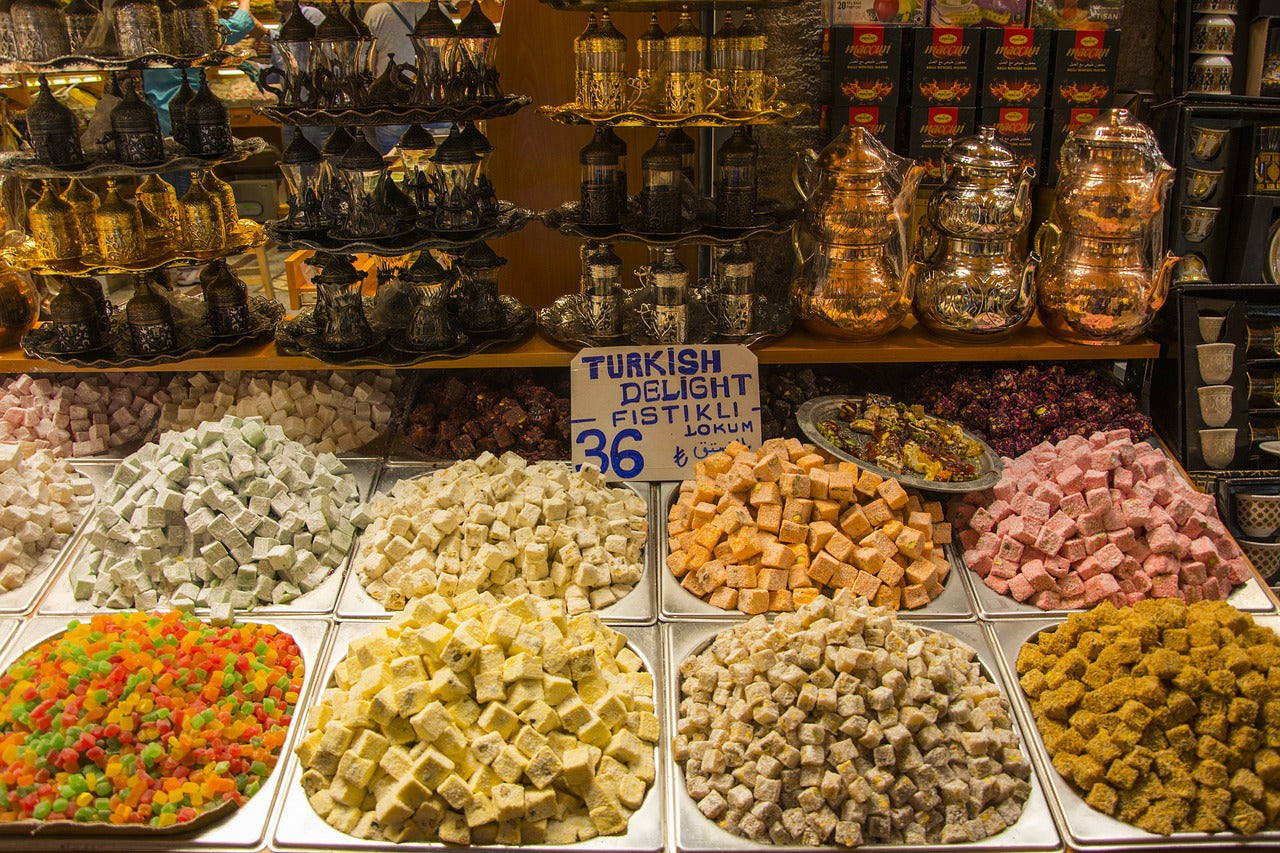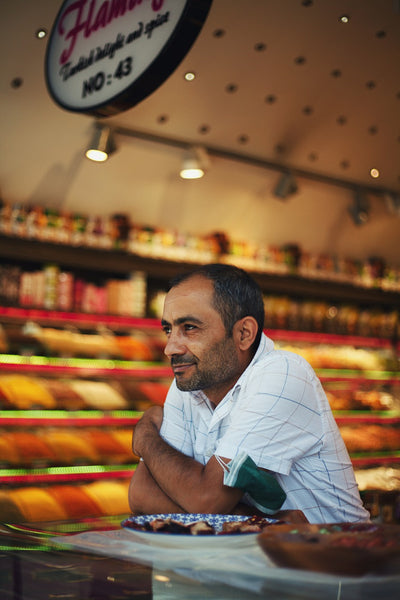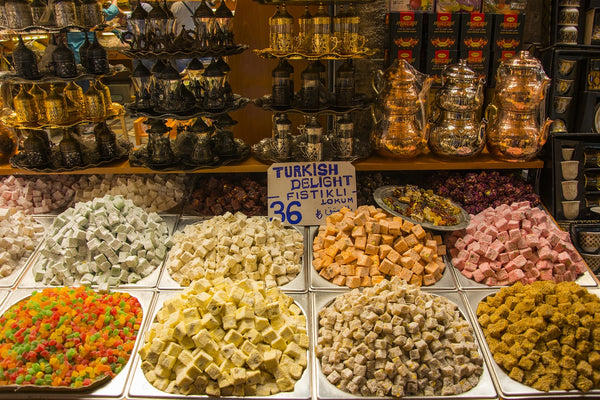
What is Turkish Delight?
Turkish delight is a staple delicacy. From the Turkish delight flavoured Cadbury chocolate bars to little sweet-smelling soft sweets from The Chronicles of Narnia, you can see Turkish delight in all parts of our everyday life.

How did Turkish delight come to be known as such worldwide? Put all puns and semantics aside, the real story of Turkish delight reveals a fascinating story about how this simple but adorable recipe managed to win hearts and those with a sweet tooth around the world.
First of all, let’s explore “the legend of the Turkish delight.”
The legend of the Turkish delight
There are several stories about the history of Turkish delight. The most popular and one of the most mythical beings was an Ottoman sultan angrily calling his Şekercibaşı (chief pastry chef) in the imperial kitchens at Topkapi Palace. The Sultan then orders him to prepare a sweet delicacy that soothes the throat and ensures it is not too hard on his tooth. He previously chipped his tooth on candy. But this report and the less certain information of another sultan, who carried Turkish delights with them to woo the ladies.

As fun as imagining the Sultan grilling his kitchen staff over candy or wooing potential lovers with candy, these contradicting accounts are far from the truth due to the lack of documented historical accounts and widely controversial and considered a myth among Turkish historians.
However, the delicacy has been around for centuries. The mastery of getting just the right viscous consistency has been passed down from generation to generation – not to mention maintaining traditional recipes, ingredients, and methods, as well as increasing sophistication with well over 100 different flavors. This time everything is documented.
The real Turkish delight
The oldest and best-documented account of Turkish delight traces back to an Anatolian man named Bekir Efendi, later titled Hacı Bekir, after fulfilling his pilgrimage duties. Hacı Bekir emigrated to Istanbul to found his now-legendary pastry shop in 1777, which is still in the Bahçekapı district today. In fact, this very first shop owned by Haci Bekir and himself, who served an Ottoman mother with their two young children, was the subject of a watercolor painting by Amadeo Preziosi, a Maltese painter best known for his paintings of the Ottoman Empire and the Balkans in the 18th and 19th centuries. The picture is currently on display in the Louvre in Paris.

Hacı Bekir’s soft and fragrant Turkish delights quickly became popular with the locals, and it wasn’t long before the news reached the palace. He was soon appointed Şekercibaşı (Chef pâtissier) of the Imperial Kitchen of the Topkapı Palace, which hosted daily feasts for the palace’s residents, including the royal family and prominent diplomats of the Ottoman Empire in Istanbul. Since then, Hacı Bekir’s Turkish gourmet recipe has received countless awards at home and abroad in Europe, which has been decorating the walls of its shop for almost 300 years, along with branding inspired by the Ottoman Baroque.
Lokum “Turkish Delight” in Europe
Turkish delight is known among Turks and many Middle Eastern cultures as lokum ( from the Arabic influenced Ottoman Turkish word rahatü’l-hulkum means “soothes the throat or comforts the throat”).
With the influx of European travelers to the exotic land of the Ottoman Empire in the early 19th century, travelers were led to Lokum in Istanbul and brought boxes of delicacies. However, the term Turkish Delight was coined by the British merchants who first imported the little bits of sugar-dusted soft candy on the shores of Britain as their fame grew. Ultimately, Lokum found its way into the handkerchiefs of the European elite as a rare, expensive delicacy that could be enjoyed and only made available to the right people.
This is how Turkish delight made its way into popular Western literature in the 1800s and appeared in many diaries kept by those fortunate enough to stumble upon these “lumps of joy.” In fact, much earlier than the popular CS Lewis novel, The Chronicles of Narnia, in Edwin Drood’s book The Secret of Edwin Drood, Charles Dickens referred to Turkish Delights as Rosa Bud, Edwin mentions a shop called “Lumps of Delights” where he “has a Turkish Bonbon, sir” works out.
What’s in a Turkish delight?
The basic ingredients of Turkish delight are corn starch, powdered sugar, and various oils and flavors, along with any dried fruit or nuts, depending on your taste. Most modern iterations have also used gelatin as a setting agent. You can find numerous recipes that recommend its use. This is almost blasphemous for any artisan who wants to create authentic Turkish delights traditionally. You can only get the perfect texture using this traditional method, resulting in a gradually melting Turkish delight as it settles towards the throat and slowly releases a heavenly blend of flavors from the oils and fruits.
How is Turkish delight made?
The secret of Turkish delicacies lies in the laborious process of slowly cooking cornstarch and sugar syrup over low heat for several hours. This results in dense jelly-like sticky bits of flavored candy. The soft jelly mixture is then cut into small cubes and dusted with powdered sugar. To achieve the perfect crossover, you need that special Turkish recipe that was reported by a French traveler who has witnessed how it was prepared in the imperial kitchen.
Flavors of Turkish delicacies
A whole range of flavors is now available. The most traditional and oldest are Turkish delicacies with rose water and orange blossom water flavor. The Turks can coat themselves with crushed nuts. The most popular are roasted pistachios, hazelnuts, and coconut flakes, which are added to the mixture and rolled layer by layer for a sushi-like presentation.

There are well over a hundred varieties and combinations of Turkish indulgence (possibly even more, including limited editions or seasonal flavors, mainly made during the months of Ramadan). The most popular flavors of Turkish delicacies are rose, lemon, orange, pomegranate, mint, mastic pistachio, hazelnut, walnut, and cream. More recently, chocolate-covered Turkish delicacies, as well as other exotic flavors such as coffee, have also gained popularity.
How to best enjoy Turkish delight
Turkish Delight in Turkey is primarily consumed in moderation and on special occasions, as is the custom of making Turkish delight a joyful experience such as the birth of a newborn baby, friend, and family during the festive months of Ramadan.

However, having Turkish coffee is also an occasion for the Turks, and that is an occasion that is often associated with a luxurious Turkish treat. Turkish coffee is usually served with a cube or two of double-roasted pistachio delights at most farms and households. It is common to take Lokum before and after coffee and to clean the palette with water every time.

